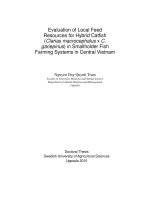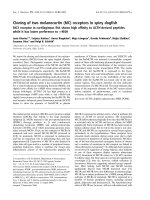Tetrodotoxin, dangerous toxin in puffer fish
Bạn đang xem bản rút gọn của tài liệu. Xem và tải ngay bản đầy đủ của tài liệu tại đây (260.68 KB, 19 trang )
Tetrodotoxin - dangerous toxin in puffer fish
Group 3 :
Enkhbayar Batsukh
Hoàng Thị Giang
Nguyễn Việt Hà (team leader)
Vũ Thị Hạnh
1.
2.
3.
4.
Contents
I. Introduction
II. Mechanism of Action
III. Symptoms and treatments
IV. Conclusion
I. Introduction
On 7th Sep 1774, Captain James Cook recorded his crew eating some local tropic fish,
then feeding the remains to the pigs on board. The crew experienced numbness and
shortness of breath, while the pigs were all dead the next morning
What do you think happened to them??
Tetrodotoxin (TTX) is one of the most potent neurotoxin.
I. Introduction
Structure
Properties
• Molecular formula: C11H17N3O8
• Molecular Weight: 319.2706 (g/mol)
I. Introduction
IUPAC name: Octahydro-12-(hydroxymethyl)-2-imino5,9:7,10a-dimethano-10aH-[1,3]
dioxocino[6,5-d]pyrimidine-4,7,10,11,12-pentol.
Other names:
anhydrotetrodotoxin
4-epitetrodotoxin
tetrodonic acid
TTX
I. Introduction
Properties
White crystalline solid, odourless
Heat stable
Soluble in dilute acetic or sulfuric acid.
Limited solubility in ethanol and ether.
Insoluble in organic solvents
I. Introduction
Source
Mostly found in puffer fish and several other animals like
blue-ringed octopus, rough-skinned newt.
Made by relatively common marine bacteria, specifically
Pseudoalteromonas haloplanktis tetraodonis, that
associates with these animals.
II. Mechanism of Action
Pathway:
oIngestion
oInjection
oInhalation
oThrough abraded skin
II. Mechanism of Action
Conduction of nerve impulses along nerve fibers and axons
II. Mechanism of Action
TTX molacular
II. Mechanism of Action
When Na+ Channels are blocked, an action potential can not be initiated and
muscles can not contract. This is important for things like…
Breathing
II.Mechanism of actions
Toxicity potential depends on what part of the puffer fish you eat!
- High concentration mainly in liver!
Case study in animals: TTX from puffer fish
from the Red Sea in Egypt.
=> LD50 (gonad) = 6.26mg/kg
LD50 (skin) = 27.9 mg/kg
Health risk assessment :
LD50(mg/kg, rat, oral) = 0,1
LD50(microgram/kg, human) =2
Lagocephalus collected
III.Symptoms and treatments
1.
Symptoms
Time course :
-. Rapid onset (10 to 45 min) and delayed onset (3 to 8 hours)
-. Death usually occur within 4 to 6 hours
Symptoms of TTX poisoning
Stage 1
- Slight numbness of lips and tongue immediately
Stage 2
- Increasing paresthesia in face and extremities
- Sensations of lightness and floating
Stage 3
- Increasing paralysis
- Convulsions, mental impairment, cardiac dysfunction
Stage 4
- Central nervous system (CNS) dysfunction
- Complete paralysis
- Death
2. Treatment
At home:
- let patients vomit but prevent from choking,
- take activated charcoal with the dose:
Adults: mixture of 30g + 250ml water
Children 1-12 years of age: mixture of 25g + 100-200ml water
Children under 1 year: oral 1g/kg weight mixed with 50ml of water
Then transfer immediately to a hospital.
IV.Conclusion
1.
2.
TTX is contained in many various kinds of marine species =>
information about them is essential since there is no antidote.
We can be exposed to this violent toxin by 4 ways, but in most cases,
ingestion was the only common.
In the scientific studies, it is proven that gonads are more lethal than skin
of puffer fish.
IV.Conclusion
3. The time effect is acute. Death may occur within the first 4 to 6 hours. And
it causes serious pain.
=> Recommendation
a.
b.
Should not use puffer fish for food.
Should know and remember the first aid of TTX poisoning to protect
yourself in case of accidental exposure.
Thank you for your listening
Q & A sections









